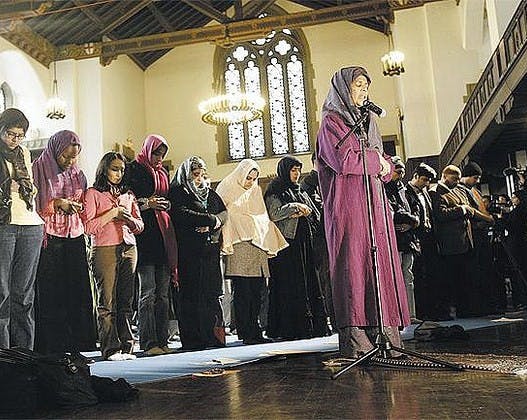Islamic feminism: interplay of modernity and tradition
Jan 21, 2015
Story


For some, islamic feminism is oxymoronic , while for others ,it sounds clichéd . But to many educated and working women in Muslim societies, it’s an issue of earnest attention at any given time. However, neither is it synonymous with classical western feminism nor contrary to it.
The core difference between the two is role of the institution of family. In classical (western) feminism, commitment to family has little importance while in its Islamic version the very institution is vital for her womanhood.
Another major departure is a Muslim feminist’s respect for cultural norms of covering her body. Her feminism is not expressed in exposure of her figure or skin to the world. For a decade, Islamic feminism has face distortions from the state, halting its natural development or evolution.
While French take the lead in headscarf ban in the European continent, Syria has come from behind and taken the lead much to the chagrin not only of the world but to its people as well. Being a Muslim majority Arab nation, Syria has set a unique example by preventing university students and working women from wearing veil (niqab).
So far 1,200 defiant female teachers have been removed from teaching assignments to administrative positions while an uncounted number has the doors of higher education shut on them.
The fresh step is in fact a follow up to last year’s proposed personal status law that was rejected after being branded as an alleged effort to promote sectarianism. The draft law had failed to acknowledge the Syrians who don’t want their religion to determine the scope of their civil rights.
Even more problematic was the fact that the draft affirmed that the Hanafi school of Islam is the source for law and that it suggested its application to all Syrian citizens regardless of whether they are even Sunni. The draft law had failed to resolve the major problematic issue of a girl’s consent to marriage and her minimum age for being a wife. The current law certainly does not go far enough on these matters.
Unlike a year ago, the controversial veil ban law has much appeal in large groups of so called secular Syrians. Many opinion writers discussed in newspapers disadvantages of wearing a veil, while pleading take-it-off position. Some argued that the phenomenon of veil obstructs space for expanding the civil society in Syria.
In Al-Hayat newspaper, for example, Yassin Haj Saleh described the veil similar to a moving prison which a woman carries with her everywhere. "The veil is not compatible with the idea of public participation, which is supposed to be the embodiment of citizenship". He believes that veil excludes women from societal interaction.
Bassam Al-Qadi, editor-in-chief of a Syrian women’s website, said: "We need to pass a law against anyone (directly or indirectly) forcing a woman to wear the veil and put him in prison."
Another journalist wrote in All For Syria website that it hurts her when she sees a veiled woman as it is a reminder of extremism, intolerance and undermining dignity of women. "We now have to get this Black thing out of our universities and throw them in the streets or better yet, bury them in homes." Even another commentator went to the extent of saying that veiled women prevent him from living in peace and freedom!
This uniquely radical reaction for the sake of secularizing Syria has always adopted a trademark angry speech, thus taking issues away from finding solutions. The self-righteous ultra-secular elite reflect individual opinion as if airing a national consensus. The debate over denying women from wearing veils has met a reactionary outcome. The streets of Syria reflect increasing religiosity, sometimes extending to the areas of political and public life.
Prior to this law, girls could go to universities for higher education, with nearly half of them from countryside wearing conservative dress. Thus, they inspired others to follow the suit in dress code.
Economics became another factor for women to wear abaya and niqab (veil) in urban areas as it helped hide their financial standing exhibited normally through dress, accessories and jewelry.
If opening up means trying to imitate the west then, many here believe, we get too far from ethical parameters that control behavior of an individual in a Muslim society and culture. Analysts say that this perception prompted many women to return to religion for finding replies to questions either the Western modernity does not address or fails to suit their Islamic cultural identity.
Ultra-secular thinkers in Syria overlook an empirical fact that with increase in a woman's knowledge and experience, she takes on veil and scarf , not the otherwise as it “provides a comfort in dealing with the aggressive male-dominated environment” around her. Dalal Albezri, a well- known Lebanese researcher in her book ‘Sisters of Shadow and Certainty’ says that a veil confirms a woman’s commitment to religion as well as society.
Alia, one of her characters responsible for female intuitions of Hezbollah, is quoted as saying, “The scarf reflects humanity of a woman and not her femininity."
After the failure of discourse by the western feminists in Syria, who could not come up with any solutions for women, many educated women returned to Islamic feminism to correct their image in the community by, reinterpreting the Koran and Hadith.
The 75,000-strong Alqubisiyat, a religious group of educated women workers which recently got permission to carry out their work, has made its impact in the Syrian society despite serious opposition to their activities. These educated women interpret their rights from the Koran and Hadith to gain equality with men. Some even say that they can do and even have done what men can’t.
After all, what is wrong with women seeking to integrate modernity and tradition in their lives which can be suitable to their societies or communities! Why attack veiled women if we assume that veil is a type of violence practiced on them? Moreover, why is veil being seen as different from traditional scarf while taking off both does not provoke any reaction?
Margot Badran, senior fellow at the Center for Muslim-Christian Understanding, Georgetown University, in one of her researches at the American Research Center in Egypt says, “Islamic feminism transcends and destroys old binaries that have been constructed. These included polarities between ‘religious’ and ‘secular’ and between ‘East’ and ‘West’.” She believes that Islamic feminism demonstrates common concerns and goals, starting with the basic affirmation of gender equality and social justice.
Undoubtedly, the Islamic feminists have started coming up prominently in Syrian with the Koran being their source in a bid to re-reform the society and integrate modernity with tradition. Islamic feminists believe that many Hadiths are taken out of context; some are weak and shaky. So people and scholars are re-reading and re-analyzing them. Women take of Aisha, wife of the prophet who led the famous battle ‘Battle of the Camel’ as a (traditional) historic example of successful Muslim woman. Fatima Mernissi, a great feminist thinker from Morocco, made her name for re-reading Hatdith and re-interpreting history to guide Muslim women. Amina Wadud became the first female Imam for men and women both in our new history. They are greatest examples of interplay of modernity and tradition for the Muslim women.
By Alia Turki Al-Rabeo




